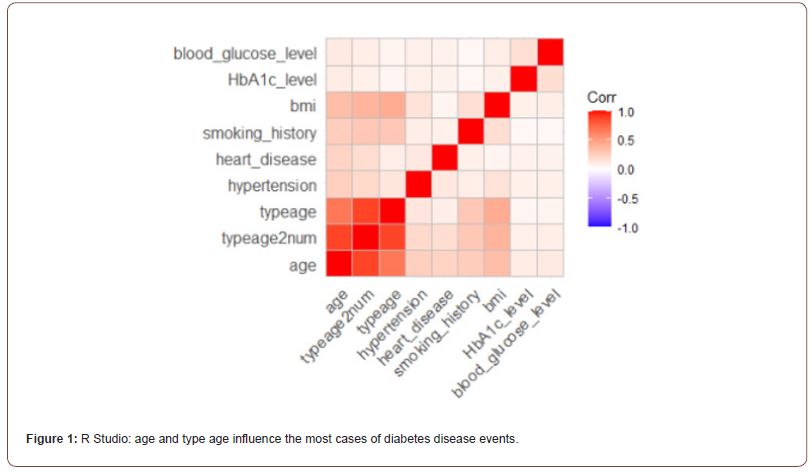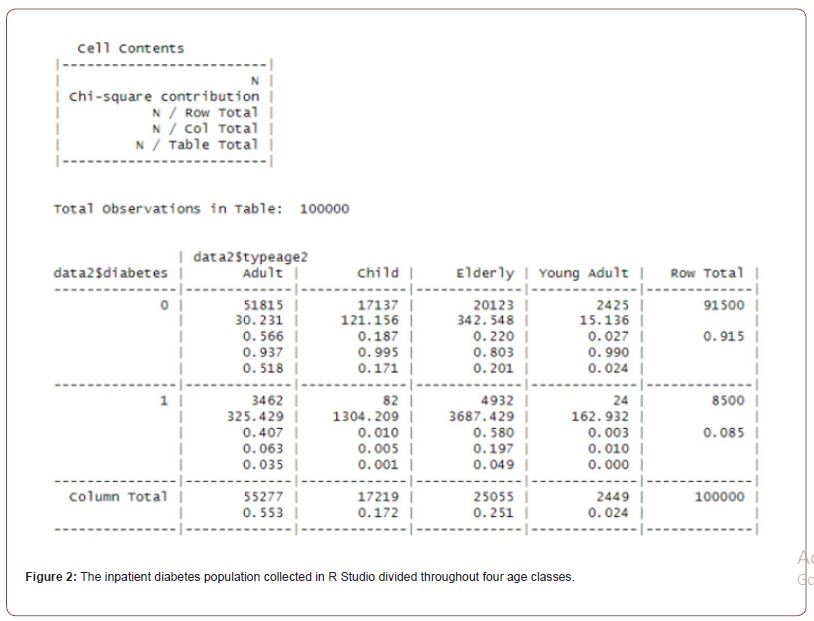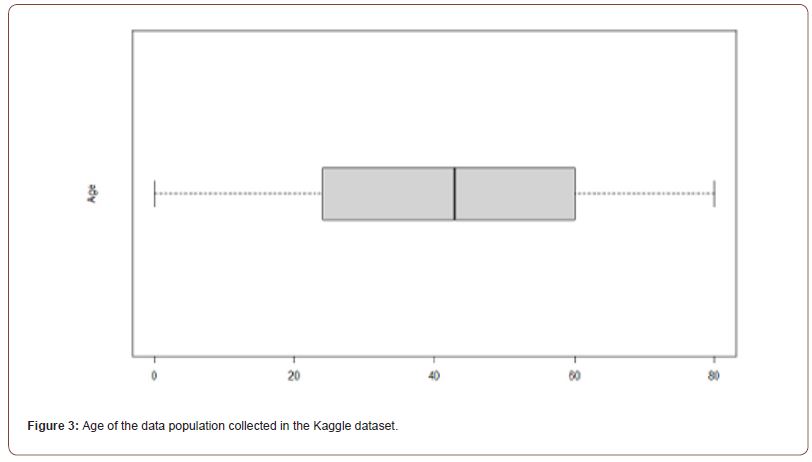 Research Article
Research Article
The Risk Factors of Diabetes among Children - Case Study
Cauli Alessandra*
Politecnico di Torino, Corso Duca degli Abruzzi, Torino, Italy
Cauli Alessandra Politecnico di Torino, Corso Duca degli Abruzzi, Torino, Italy
Received Date: April 27, 2024; Published Date: May 09, 2024
Summary
This report examined a population of data extracted from one population of 100.000 inpatients was the first eligible as statistical surveillance review of clinical data during the study and it is about the higher risks of developing diabetes in children. Then, we selected 8.500 positive susceptible individuals from the initial population, and we consider child individuals as an uncenter cohort, subjected to this study. Some data indicate the possibility to measure the hypertension, heart disease, the smoking history, BMI, the blood glucose level and the haemoglobin A1c level of the overall population of clinical inpatients while positive statistical population of individuals draw a prospective scenario for future patients in the same conditions and for future audience segmentation of more populations of individuals evaluating the knowledge of healthcare conditions from real data, they were processed in R Studio.
Keywords: R Studio; diabetes; surveillance analysis; risk factors; pathogenicity
Reasons for performing study: Information on precision medicine of diabetic individuals in the healthcare structures for disease prevention and control during the collection of data from new inpatients.
Objective: To prevent clinical findings in healthcare structures among inpatients with diabetes disease to describe the distribution of positive population of some groups of populations for studying hospital outbreaks.
Background: Diabetes diseases and pathogenicity-related genes are studying through the positivity rate ranking all possible and the types of diabetes disease of involved individuals for assisting hospital onsets. We aim to estimate the sensibility of illness presentation which it is associated with higher levels of some indicators used as confoundments in our statistical analysis, studying the proportion of risk factors by means of the risk and fitness factors studying the interactions regardless the hypertension, heart disease, the smoking history, BMI, the blood glucose level and the haemoglobin A1c level, deducing human susceptibility to diabetes disease. During laboratory cross-contamination, receptors are recognizing pathogenic profiles in the environment of humans and their sequential event reading permits to diagnostic several acute episodes of the disease.
Study design: Prospective cohort study.
Methods: Demographic data on the individuals involving admission and stool, sampling inpatients from 100.000 of recorded individuals were used to estimate the proportion of risk factors related to the developing of the diabetes disease. The association between heterogeneous data with age and gender are fixed effects whereas data wards are including as a random effect in the statistical analysis. A cross sectional Point Prevalence Study (PPS) is conducted in a sample of inpatients as described. The surveillance methodology is based on machine learning approaches and different techniques in R Studio had applied for the obtaining results.
Results: This case study identified 8.500 positive of 100.000 adherent inpatients. The uncenter cohort dataset characterizes 82 susceptible children. The presence of an uncenter control cohort resistant organism is documented for % of patients. There are 17.219 children present in 100.000 patients. The prevalence of patients who are of type age as children is 17.2% whose female individuals is the 58.5% and the 41.5% are male. Hospital positivity rates ranged from 0.02% among young adult and to 4.9% among elderly people. Body Mass Index (BMI) ranged from 10.01 to 95.69 kg/m2. The most common positive inpatients --with other cofounder-- are comprising % of all patients identified.
Main limitations: The dataset of patients is not related to some hospital structure in specific Italian Region or other and few demographic data are conditioning the results onto treatments. Then, the outcomes of principal pathology and life tenure of the patient is a priori unknown because of the absence of some features characterizing the initial data. No distinction into type I and type II of the disease is present in the data.
Introduction
Significant evidence of the difference among children whose mother smoked, compare to those whose mother did not: they consisted of a reduced risk of developing type 1 diabetes under the age of 15 years, as stated in [1,2]. Risk factors of Type 1 diabetes mellitus in children attending Aswan University Hospital, was wide, like wide range of geneticist, environmental, maternal and neonatal, that may have contributed to the development of T1DM, as in [3]. In [4], authors wrote an update guideline to recognize type 2 diabetes disease among children and adolescent. A questionnaire to better understand type 2 diabetes is given in [5] where they are listed the Criteria for the diagnosis of diabetes.
Materials and Methods
Sampling from Dataset Populations of Inpatients
A population of 100.000 inpatients was eligible as a first statistical surveillance review of clinical data during the study period to calculate the case-finding survey of positive patients of diabetes disease. One population of 8.500 positive individuals from the starting population we consider as an uncenter cohort of individuals for characterizing positive patients for our previsions. Two clinical cohorts’ prospect observational cases of colonized or isolated diabetes inpatients were adherent to screening for registering data. Unfortunately, the set of observed past events matters rather than the order of past events for updating medical tenure and treatment predictions are not available. We retrieve the hypertension, heart disease, the smoking history, BMI, the blood glucose level and the haemoglobin A1c level indicators, mainly to measure the susceptibility of the overall population of clinical inpatients during the study period for this disease.
During this studying observed data, it is remarkable they will produce a suitable scenario for future patients in the same conditions and future inpatients with other clinical features as prospecting an audience segmentation of more populations of individuals showing the illness of diabetes disease, comparing it through several evaluating and evaluated known models. Analysing the type of the disease exhibiting in patients will help to describe inpatients cases that they are subjected to high risk or not and several different groups of inpatients will compare from the registered, targeted and labelled population of the initial populations of individuals. Clinical inpatient features are designing through the estimate of tolerance limits defined for a statistical control process monitoring the positivity rates in the analysed populations groups. The characterization of isolated or colonized patients is implementing through unadjusted odds ratios (OR), they will be calculated for each risk factor. Factors associated with increased risk of positivity at P<0.05 on univariate analysis, along with age as an a-priori cofounder, were entered into a multivariate logistic regression model using a forward stepwise selection process.
Prevalence Risk Factors of Positive Inpatients

We highlight the study of the distribution of positive individuals of some groups of populations evaluating hospital onsets among inpatients with diabetes diseases through clinical characteristics of patients in respect to thresholds to be illness. The variables we considered in the analysis were the hypertension, heart disease, the smoking history, BMI, the blood glucose level and the haemoglobin A1c level. However, none of the risk factors were independently associated with being a positive patient. Using logistic regression, in the following table, we deduced that the only risk factors significantly associated with being a positive patient of diabetes disease were the most significantly are related to age and type age. The resulting graph describe these correlations, through a correlation matrix, we made in R Studio (Figure 1).
Results
Study of One Clinical Population of Individuals
We made a post hoc analysis of patients from whom the prediction of diabetes cases predicted from the collection of samples of the initial patient population, performed in 100.000 instances and 11 attributes, one of them being the target variable. Inpatients from two prospective observational cohorts with disease colonization or inpatients diabetes were eligible. Over the study period, 8.500 inpatients are identified as unique patients and 82 were children. The median age of patients in the study is 43 years (quartile range 25-60 years even though the overall dataset contains inpatients age from 0 to 80 years) and the 41.44% of the sample are female. The frame table in the next figure is counting the presence or the absence of the disease in individuals by type of age in order to give immediately the idea of the data distributions for evaluating and proposed known models, understanding controlled onsets. Starting with visualizing all data of all inpatients registered on the Kaggle dataset, we show in the following figure the data population divided into age of patients. Then, 82 children of 17.219 inpatients had a diabetes event, that it is the 47,62% in this dataset. In what concern the other percentages of inpatients this boxplot gives the distribution of them by age. We now focus on the children which they had diabetes disease events. The dataset considers six causes of this disease events, then we can consider if they are or not independent. They are strong correlated and they cannot consider as separates (Figures 2&3).


Discussion
There were 82 known diabetes positive patients within children, then the prevalence was of 47.62%. Instead, not only age and type of age is a risk factor for disease events, but diabetes is a major risk factor for premature morbidity and mortality caused by cardiovascular disease and early identification of hyperlipidaemia and other cardiovascular risk factors are objected factors in the report analysed in [6]. Environmental factors play an important role in the case-control study [7], it was carried out to determine the potential maternal, neonatal and early childhood risk factors for type 1 diabetes mellitus in children and adolescents in Basrah. The incidence of type 1 diabetes is increasing when suggesting a major environmental exposure had changed and the infectious causes is related to the loss of herd immunity: a comparative study did in [8], associate US and Finland, Sweden, Colorado, Germany, and Poland from 1950 to 2003. DM2 during childhood, a fact that might have underestimated the resulting prevalence, in [9]. Therefore, the prevalence of Cardiovascular Disease Risk Factors in U.S. Children and Adolescents with Diabetes is presented in [10]. In fact, [11] confirms the cardiovascular risk for diabetes diseases.
Conclusion
Even if risk factors of diabetes diseases could be considered as independent, we had shown the events depends by the age and the type of age. Indeed, the cardiovascular disease has the major responsibility as major causes. This study is only an example, reliable and reproducible by other researchers in the future times. These risk factors among children are not differentiated by type of disease, confirming the nature of the causes of higher risks.
References
- Baert L, Mathijs E, Stals A, Botteldoorn N, Denayer S, et al. (2012) A review of known and hypothetical transmission routes for noroviruses. Food Environ Virol 4(4): 131-152.
- Robertson L, Harrild K (2010) Maternal and neonatal risk factors for childhood type 1 diabetes: a matched case-control study. BMC Public Health 10: 281.
- Asmaa MI, Ahmed El-Meshwady AM, Hanan MAEM (2020) Risk Factors of Type 1 Diabetes Mellitus in Children Attending Aswan University Hospital. The Egyptian Journal of Hospital Medicine 81(6): 2265-2273.
- Panagiotopoulos C, Hadjiyannakis S, Henderson M (2018) Type 2 Diabetes in Children and Adolescents. Can J Diabetes 1: S247-S254.
- Lipman TH, Hayman LL, Fabian CE, (1997) Risk Factors for Cardiovascular Disease in Children with Type I Diabetes: Part 1. J Paediatr Nurs 12(5): 265-272.
- Majeed AAS, Hassan MK (2011) Risk Factors for Type 1 Diabetes Mellitus among Children and Adolescents in Basrah. Oman Med J 26(3): 189-195.
- (2000) Type 2 Diabetes in Children and adolescents. American Diabetes Association. Diabetes Care 23(3): 381-389.
- Stene LC, Norris JM, Rewers MJ (2023) Risk Factors for type 1 diabetes. Diabetes in America.
- Macedo SFD, Araujo MFMD, Marinho NPB, Lima ACS, Freitas RWFD, et al. (2010) Risk Factors for Type 2 Diabetes Mellitus in Children. Rev Lat Am Enfermagem 18(5): 936-942.
- Rodriguez BL, Fujimoto WY, Mayer-Davis EJ, Imperatore G, Williams DE, et al. (2006) Prevalence of Cardiovascular Disease Risk Factors in U.S. Children and Adolescents with Diabetes: the search for diabetes in youth study. Diabetes Care 29(8): 1891-1896.
- Auslander WF, Anderson BJ, Bubb J, Jung KC, Santiago JV (1990) Risk Factors to Health in Diabetic Children: a prospective study from Diagnosis. Health & Social Work 15(2): 133-142.
-
Cauli Alessandra*. The Risk Factors of Diabetes among Children - Case Study. Annal Biostat & Biomed Appli. 6(1): 2024. ABBA.MS.ID.000628.
R Studio; diabetes; surveillance analysis; risk factors; pathogenicity; iris publishers; iris publisher’s group
-

This work is licensed under a Creative Commons Attribution-NonCommercial 4.0 International License.






